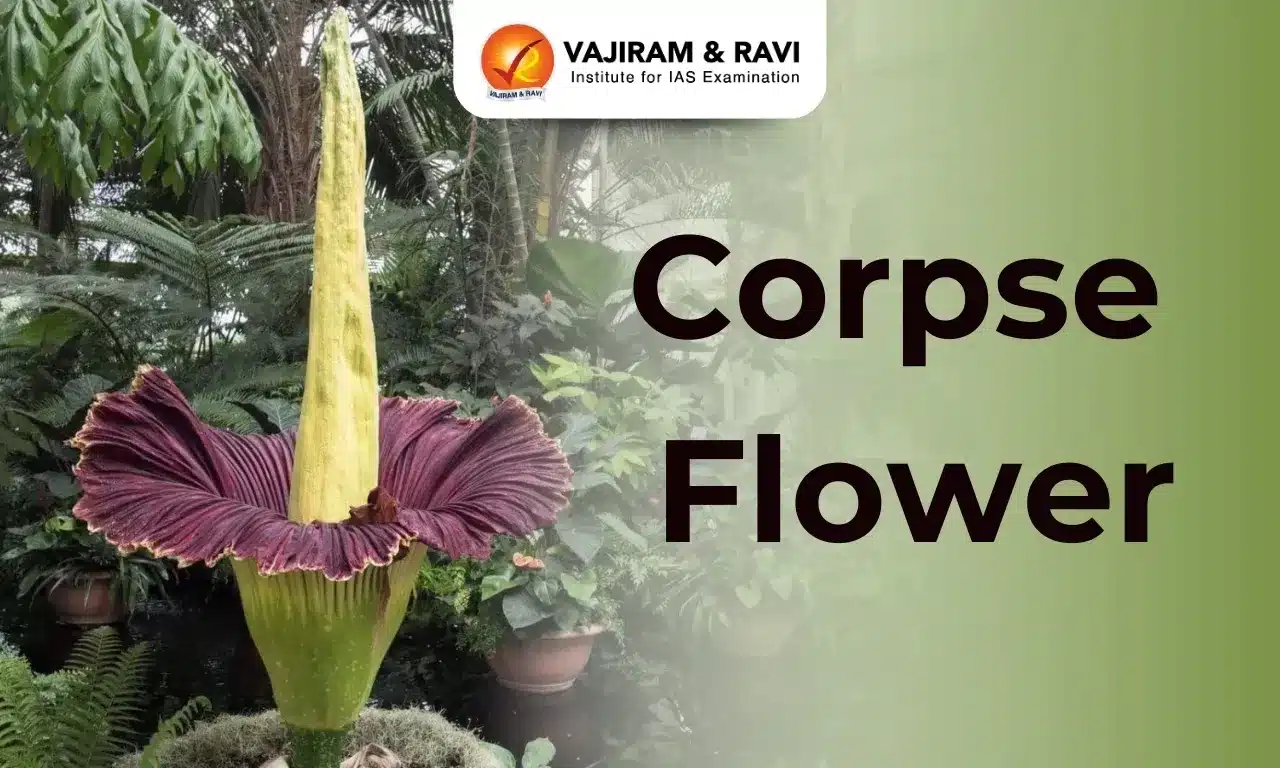Corpse Flower Latest News
Recently, a “corpse flower” at the Royal Botanic Gardens of Sydney has drawn more than 20,000 curious viewers to a special display for its much-anticipated opening.
About Corpse Flower
- It is native to the Indonesian island of Sumatra, gets its name from the literal translation of the Indonesian phrase Bunga bangkai.
- Its species name is Amorphophallus titanium.
Features of Corpse Flower
- Some corpse flowers have been known to grow 3 meters (about 10 feet) tall before revealing a phallic spadix (or spike).
- Its odor released by the spadix to attract insects is often likened to decaying meat.
- Its blooms are often inconsistent. Many will bloom once a decade, though sometimes even more frequently.
Life Cycle of Corpse Flower
- The life cycle depends on the time it takes for the “corm” of the flower to gather enough energy to bloom.
- When enough energy has been stored through leaf cycles, the flowering stage begins.
- The bloom lasts for a day, with the spathe (the purple, petal-like structure surrounding the spadix) taking hours to fully unfurl.
- Insects attracted to the odor are ones that lay their eggs in decaying meat, but they have the benefit of moving pollen between male and female flowers to trigger the flower’s reproductive cycle.
- These flowers have both male and female flowers. Female flowers open first to prevent a plant from pollinating itself. Nearby flowers are required to bloom at similar times in order for cross-pollination to be possible.
- Chemicals emitted during female flowering are: Dimethyl disulfide, Dimethyl trisulfide, 3-Methylbutanal, Dimethyl sulfide and Methanethiol, Methyl thioacetate and Isovaleric acid.
- It is categorized as Endangered by the IUCN.
Corpse Flower FAQs
Q1: Why is it called a corpse flower?
Ans: It is commonly called the corpse flower because its scent is reminiscent of rotting flesh,
Q2: Where is the corpse flower originally found?
Ans: It is native to the rainforests of western Sumatra, Indonesia
Q3: Is the corpse flower found in India?
Ans: No.
Source: WE
Last updated on December, 2025
→ Check out the latest UPSC Syllabus 2026 here.
→ Join Vajiram & Ravi’s Interview Guidance Programme for expert help to crack your final UPSC stage.
→ UPSC Mains Result 2025 is now out.
→ UPSC Notification 2026 is scheduled to be released on January 14, 2026.
→ UPSC Calendar 2026 is released on 15th May, 2025.
→ The UPSC Vacancy 2025 were released 1129, out of which 979 were for UPSC CSE and remaining 150 are for UPSC IFoS.
→ UPSC Prelims 2026 will be conducted on 24th May, 2026 & UPSC Mains 2026 will be conducted on 21st August 2026.
→ The UPSC Selection Process is of 3 stages-Prelims, Mains and Interview.
→ UPSC Result 2024 is released with latest UPSC Marksheet 2024. Check Now!
→ UPSC Prelims Result 2025 is out now for the CSE held on 25 May 2025.
→ UPSC Toppers List 2024 is released now. Shakti Dubey is UPSC AIR 1 2024 Topper.
→ UPSC Prelims Question Paper 2025 and Unofficial Prelims Answer Key 2025 are available now.
→ UPSC Mains Question Paper 2025 is out for Essay, GS 1, 2, 3 & GS 4.
→ UPSC Mains Indian Language Question Paper 2025 is now out.
→ UPSC Mains Optional Question Paper 2025 is now out.
→ Also check Best IAS Coaching in Delhi

















